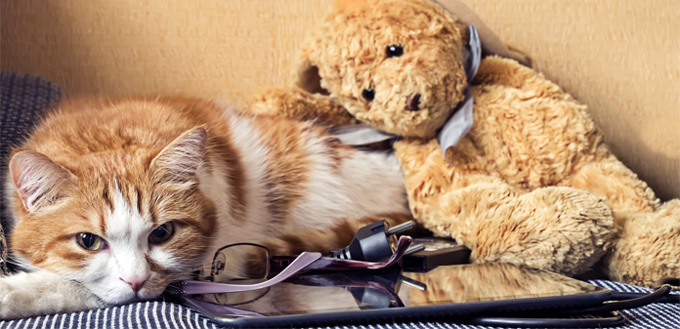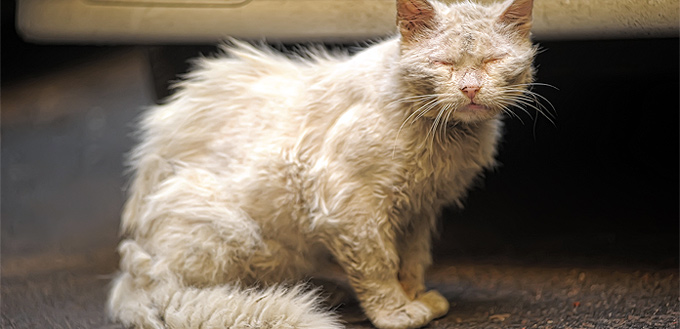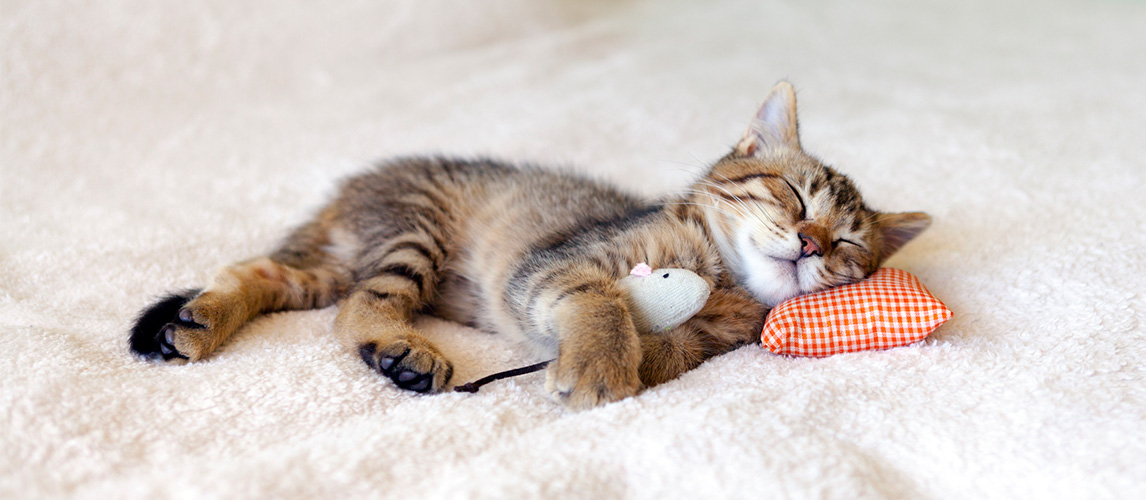As cats age, they also get arthritis, even though you would never notice it. Your feline friend is actually very good at hiding any signs of illness, including pain because it is considered a sign of weakness. It does not help either that any symptoms of arthritis they have would be very subtle, which is why many cats remain undiagnosed.
The fact is, about one-third of cats actually develop arthritis at 6 years of age, and by 12, about 90% of them have it. This means if your cat is a “senior”, then it will most likely be suffering from arthritis.

What Causes Arthritis in Cats
The biggest contributors to feline arthritis are obesity and a sedentary lifestyle. Over time, the joints undergo a lot of wear and tear, leading to joint instability. Some other factors, like genes, injury, cancer, and infection might make it worse. Also, certain cat breeds are more likely to develop arthritis, which includes Burmese, Maine Coons, Abyssinians, and Scottish Folds.
Arthritis may affect one or many joints. Most of the time the joints at the elbows, spine, and hips become worse. These joints have a layer of cartilage called the synovium. This works as a cushion, making it possible for the bones to move easily. Plus, the synovial fluid in the joints will provide some additional lubrication.
When your cat has arthritis, there is deterioration in the cartilage and the synovial fluid does not lubricate properly, leading to rougher movement of the bones. This leads to discomfort and pain, eventually reducing the mobility of your pet.
Despite this, your kitty will still be light on its feet and nimble, and will not show any sign of discomfort. You will also not see it limp around or have problems getting up like humans with arthritis do. They will, however, show it differently through their behavior.
Signs of Arthritis in Cats
- Reduced Movement
Although older cats will no longer be as wild as a kitten, you should notice it moving much less than normal. If you notice your pet being unable or reluctant to jump up or down from furniture or any sleeping area, it might mean they find it difficult to do so. Instead, it might want to sleep somewhere more accessible.
Your cat may also find it difficult to get in or out of litter trays that have high sides, which end up in unpleasant accidents in your home. Lastly, you might notice it walking with a gait.
- Changes In Its Grooming Behavior
Some cats end up grooming less because of the pain, resulting in growing or matted or scruffy coat. On the other hand, other kitties over groom the joints that are painful, which results in some hair loss or inflamed and infected skin in the area.
Related Post: Best Cat Grooming Gloves
- Personality Changes
Some cats with arthritis will display several changes in their personality. For example, those that are usually good-natured might become more aggressive. They might also show a dislike to being held, patted or brushed in areas affected, specifically close to the back legs and tail.
- Changes In Activity Level
You might also notice your cat being more sedentary and even reluctant to go out to play, explore or hunt. While old age might make them lazier, it might actually due to the pain. Your kitty might also stop using a cat scratching post, resulting in long nails.
If your pet is displaying one or more of these symptoms, then you should call your vet and make an appointment to get it diagnosed. You will be able to find the underlying reason for the change in behavior and the sooner you find the cause, then the sooner you can get it treated.
Related Post: Best Cat Food for Weight Loss
How to Help Your Aging Cat
You do not need to wait for your cat to reach an advanced age before you pay attention to its joints. Unfortunately, the damage starts much earlier, which is why taking early steps can help avoid or delay arthritis.
The most important step to prevent or even alleviate the symptoms of arthritis in your kitty is to maintain a healthy and lean weight. When the cat is overweight, this makes it difficult for the joints. A cat that already has arthritis can still see a great improvement in the symptoms when it loses some weight.
As your feline friend grows older, wasting of muscles, or atrophy is normal. This means it might be tougher to maintain its muscle tone. Unfortunately, many pet owners make the mistake of thinking that their older cat does not need as much anymore due to the shrinking muscles.
This is not correct, because your cat needs to move more as it is aging in order to offset the muscle atrophy. However, there should be a change in the type, intensity, and duration of the exercise. Still, daily exercise is crucial in preventing the muscles from getting weaker in time. Keeping the muscle tone is vital because it maintains its frame and doing so will reduce the laxity of joints that cause arthritis.
Unfortunately, many cats do not get the necessary exercise, as they only normally walk to their food bowl, litter box, and sleeping area. There are ways for pet owners like you to make them move more. For example, you can carry its bowl around the house during meal times so that it follows you. To reward it, give it a bite of food after every lap. This technique of “move and eat” is an easy way to improve its range of motion and improve its flexibility.
Related Post: Best Cat Litter Box
Another important step is to give it the right, balanced diet to avoid obesity. You should also try to avoid unnecessary vaccinations and lastly, giving it tons of opportunities to stay active at all times. Kitties love it the most when their humans play with them so invest in interactive cat toys and allocate some time to play.
Related Post: Best Cat Beds
How to Treat Arthritis
When you go to the vet to get your cat diagnosed with arthritis, it is important to share your observations that will help him identify what is happening with your pet. However, radiographs and blood tests will be performed in order to check its joints and assess its condition. Once diagnosed, he can help develop a personalized plan to help manage the kitty’s arthritis.
- Weight Management
As mentioned above, managing a healthy weight is vital to prevent further issues with the joints and your cat’s mobility. Overweight kitties will also experience more pain, inflammation, and irritation of the joints. In turn, this can contribute to the progression of arthritis. Gradual weight loss is important to also avoid any metabolic issues, so discuss your diet and weight-loss plan with your vet.
Related Post: Best Cat Food for Weight Loss
- Changes At Home
A cat diagnosed with arthritis will require some changes at home to cope with their condition and make them more comfortable. Like humans, the cold makes the joints more painful so they need a sleeping area away from drafts. Low-sided litter boxes are better for easy access and preventing toilet accidents.
Your kitty will also find going up favorite furniture more difficult, so putting steps or other aids can help them. You will also need to trim their nails yourself or get a grooming service to keep them short. If they are not grooming as much, you would need to brush their coat more often to prevent matting.
Related Post: Best Cat Brush
- Medication And Vet Treatment
There are also other options to deal with the symptoms and to manage osteoarthritis in cats. Your vet will determine which are appropriate based on its age, the severity and progression of the disease, as well as overall health status.
First, there are disease-modifying osteoarthritis drugs like Pentosan polysulfate that can be administered as injections. This is done once a week for a month and a full course of 4 injections should be repeated every 6 to 12 months. They function great in stabilizing joint membranes, helping to repair joint cartilage and improving lubrication of joints. They are very successful in improving the condition of most cats and have very few side effects.
Second, there are anti-inflammatory and pain relief medications available but it is important to use only what the vet prescribed. This is because some kitties are sensitive to NSAIDs. However, they are very effective in reducing joint inflammation and relieving pain associated with arthritis. Taking these medications should be partnered with regular visits to the vet to monitor the liver and kidney function of your pet. He can then assess the most appropriate medicine and the proper dose for your cat so that it will respond well to the treatment.

Lastly, there are dietary supplements that have Glucosamine, Fish Oils, Chondroitin sulfate, and Green Lipped mussel that are effective in protecting the joints and reducing inflammation. These can be given over a long period of time.
Arthritis in cats is a very common and manageable condition with the help of your veterinarian. Pet owners can benefit a lot from knowing about this disease early on to take the necessary steps to prevent it and maintain their kitty’s mobility and quality of life for as long as possible.

Sources:
- S.Dawson, Acute Arthritis Of Cats Associated With Feline Calicivirus Infection, ScienceDirect
- Arthritis & Degenerative Joint Disease in Cats, International Cat Care
- Integrative Treatments for Dog and Cat Arthritis, Best Friends Animal Society







